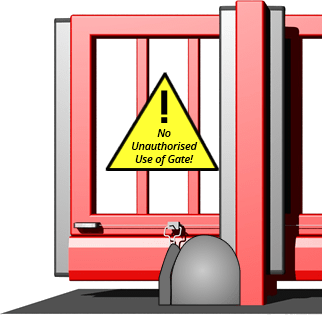Your shopping cart is empty!
Menu
- +
-
Gate Automation+
-
Safety Solutions+
-
Access Control+
-
Garage Doors+
-
Intercoms+
- Home Automation +
-
Electrical+
-
CCTV+
- Networking +
-
Offers+
- News +


When commissioning a new gate installation, you are required to comply with the machinery directive. This applies to all of the below.
Full compliancy to the machinery directive safety guidelines may vary with commercial & residential gates that meet the below criteria. In these scenarios the risk assessment carried out may identify reduced risks associated with the use of the gate. However even in these circumstances consumer's, Owner's, Installer's & Service Engineer's safety when using the gate must be considered.
The current machinery directive MD2006/42/EC came in to force on 29/12/2009, however there were no significant changes from the previous revision Supply of Machinery (Safety) Regulations 2008. In addition to the directive both the Health & Safety at work act 1974 and Workplace (Health, Safety & Welfare) Regulations 1992 can be used in relation to any gate incidents and have been used to prosecute in one case already by the HSE.
Manufacturers and installers of automatic gate systems who provide maintenance of gates should take steps to address safety on existing sites. Companies should consider making contact with their existing customers to update them on legislation & machinery directive requirements and offer a risk assessment service to ensure the gate is safe, including any safety upgrade recommendations. If the person or company responsible for the gate declines to have any safety upgrades applied the installer must make record that the upgrades were refused.
The risk assessment is an essential requirement and is used by the installer to demonstrate that a gate is safe to be worked on and used. If an installation is described as dangerous to the general public or employees on a commercial or industrial site, the installer should notify the client that the gate in question should with immediate affect be taken out of service. The gate should not be placed in use again until the gate is singed off as meeting the machinery directive guidelines and compliance with a declaration of conformity.
If a residential installation is found to be dangerous to the public or authorised users due to its design, location & condition then the installer should again notify the client that the gate should be taken out of service. It is possible that if the client left the dangerous gate in operation that this could fall under a Civil law claim resulting from any accident occurring on the gate.
In both of these circumstances it is not advisable for the installer to physically decommission the equipment by disconnecting it from its power source or disabling it by other method without prior authorisation from the client. The installer should follow the procedure of issuing a notice of un-safe operation in relation to the equipment to the appropriate party and not carry out further work on that gate until it has been bought in line with safety requirements.
Further references can be found here in relation to HSE Safety Advisories:

When installing a gate which is moving into or past perimeter fencing, or which is itself mesh in-filled, the following mesh sizes must be applied to the gate or fencing to prevent entrapment or draw-in. Alternately the protection can be provided by utilising an appropriate torque limitation technique, pressure sensitive edge or other “state of the art” technique full-filling the requirements set out in the harmonised standard BS-EN13241-1
| Fence Mesh Size (mm) | Distance between the leaf and fence (mm) |
| < 18.5 | 120 |
| 18.5 to <29 | 300 |
| 29 to < 44 | 500 |
| Greater than 44 | 850 |
When installing a gate which opens within 500mm of a fence, wall or other solid structure protection must be applied to prevent entrapment. This protection can be provided by utilising an appropriate torque limitation technique, pressure sensitive edge or other “state of the art” technique full-filling the requirements set out in the harmonised standard BS-EN13241-1